Let’s illuminate the world of kitchen lighting solutions, where functionality meets style to create a well-lit culinary haven. Lighting plays a pivotal role in the kitchen, not only enhancing visibility but also contributing to the overall ambiance. In this exploration, we’ll delve into various lighting options and their strategic placement to transform your kitchen into a bright and inviting space.
Firstly, let’s discuss the importance of task lighting. This focused illumination is essential for specific work areas like the countertop, stove, and sink. Under-cabinet lighting, for instance, directs light precisely where it’s needed, ensuring a well-lit workspace for chopping, cooking, and cleaning. LED strips or puck lights are popular choices for under-cabinet installations, offering both energy efficiency and a sleek aesthetic.
Moving on to ambient lighting, this layer sets the overall mood in the kitchen. Consider pendant lights or chandeliers suspended above the kitchen island or dining table. The choice of fixtures can range from contemporary designs to more classic styles, depending on the kitchen’s aesthetic. Ambient lighting not only adds a decorative element but also provides a warm and welcoming glow, making the kitchen a gathering place for family and friends.
Now, let’s explore the realm of accent lighting. This type of lighting is all about highlighting specific features or areas in the kitchen. Cabinet lighting, for instance, can showcase glassware or decorative items, adding a touch of sophistication. Accent lighting is a creative way to draw attention to architectural elements or unique design features, contributing to the kitchen’s visual appeal.

Innovations in lighting technology have paved the way for smart lighting solutions in the kitchen. Smart LED bulbs and fixtures allow for customizable color temperatures and intensity, catering to different activities and moods. With the convenience of smart home integration, you can control your kitchen lights with a simple voice command or through a mobile app. This level of flexibility adds a modern touch to the traditional kitchen.
Let’s not forget about natural light – a kitchen’s best friend. Strategically placed windows or skylights can flood the space with natural sunlight, creating a bright and airy atmosphere. Consider the layout of your kitchen when planning for natural light, ensuring that key areas receive ample daylight. This not only reduces the need for artificial lighting during the day but also connects the kitchen to the outdoor environment.
In terms of fixture styles, pendant lights are versatile and can be a focal point in the kitchen. Whether hung in a row above the kitchen island or as a singular statement piece, pendant lights come in various shapes and materials, allowing for personalization to match the kitchen’s style. They provide both task and ambient lighting, making them a practical and aesthetic choice.
When it comes to recessed lighting, it offers a clean and unobtrusive look. Placed strategically in the ceiling, recessed lights illuminate the entire kitchen evenly. This type of lighting is ideal for larger kitchens or those with lower ceilings where pendant lights might feel visually heavy. Consider a dimmer switch for recessed lights to control the intensity based on the time of day or the desired mood.

Now, let’s discuss the color temperature of lighting, a factor often overlooked but crucial for creating the right ambiance. Warm white tones, resembling traditional incandescent bulbs, can create a cozy and inviting atmosphere. On the other hand, cooler tones, leaning towards daylight hues, are ideal for task-oriented areas, providing clarity and visibility. Understanding the role of color temperature allows you to tailor the lighting to different zones within the kitchen.
In terms of trends, industrial-style lighting has gained popularity in modern kitchens. Exposed bulbs, metal finishes, and utilitarian designs add an edgy and contemporary vibe. This style works well in open-concept kitchens, seamlessly blending with both rustic and modern elements. Industrial lighting fixtures not only illuminate the space but also serve as distinctive design elements.
Consider the concept of layering when planning your kitchen lighting. Combining different types of lighting – task, ambient, and accent – creates a harmonious and well-balanced environment. This layering approach ensures that the kitchen is not only well-lit for practical purposes but also visually appealing. Experiment with different fixtures and placements to achieve the perfect balance of light.
Let’s touch on the energy efficiency aspect of kitchen lighting. LED technology has revolutionized the lighting landscape, offering energy-efficient options that last longer than traditional incandescent bulbs. LED lights consume less energy, reducing electricity costs and environmental impact. Investing in LED fixtures for your kitchen is a sustainable choice that aligns with the growing trend of eco-friendly home solutions.

Now, let’s consider the concept of lighting zones within the kitchen. Each zone, such as the prep area, cooking zone, and dining space, has distinct lighting needs. Tailoring the lighting to specific zones enhances functionality and creates a dynamic visual experience. For example, pendant lights above the dining table can be softer, while task lighting in the prep area should be bright and focused.
Lighting control systems have become increasingly sophisticated, allowing homeowners to create customized lighting scenes. Whether it’s a bright setting for meal preparation or a subdued ambiance for a cozy dinner, programmable lighting controls offer flexibility. This technology not only adds convenience but also enhances the overall user experience, allowing you to adapt the lighting to different activities throughout the day.
Consider the role of lighting in accentuating architectural features or design elements in the kitchen. Track lighting, for instance, is a versatile option that can be adjusted to highlight specific areas, such as artwork or open shelving. This strategic use of lighting adds depth and visual interest, turning the kitchen into a showcase of its unique design elements.
Kitchen lighting solutions go beyond mere illumination – they contribute to the kitchen’s functionality, style, and ambiance. From task lighting for precision to ambient lighting for mood, the interplay of different lighting types creates a well-rounded and inviting space. With advancements in technology and a wide array of fixture styles, the possibilities for designing a well-lit kitchen that suits your taste and lifestyle are virtually limitless.

Beautiful lighting solutions for your dream kitchen. Gallery fitted kitchens

Built-in Cabinet Lighting JLC Online

Kitchen Lighting Gallery

Properly Lighting Your Kitchen: 2009

Kitchen Lighting Gallery

Veneer Kitchen – Aluminum Glass Cabinet Doors

Charming Wooden Ceiling Designs For Rustic Look In Your Home

Kitchen Lighting Gallery

Kitchen Solutions Kitchen This Old House

Related Posts:
 Innovations in lighting technology have paved the way for smart lighting solutions in the kitchen. Smart LED bulbs and fixtures allow for customizable color temperatures and intensity, catering to different activities and moods. With the convenience of smart home integration, you can control your kitchen lights with a simple voice command or through a mobile app. This level of flexibility adds a modern touch to the traditional kitchen.
Let’s not forget about natural light – a kitchen’s best friend. Strategically placed windows or skylights can flood the space with natural sunlight, creating a bright and airy atmosphere. Consider the layout of your kitchen when planning for natural light, ensuring that key areas receive ample daylight. This not only reduces the need for artificial lighting during the day but also connects the kitchen to the outdoor environment.
In terms of fixture styles, pendant lights are versatile and can be a focal point in the kitchen. Whether hung in a row above the kitchen island or as a singular statement piece, pendant lights come in various shapes and materials, allowing for personalization to match the kitchen’s style. They provide both task and ambient lighting, making them a practical and aesthetic choice.
When it comes to recessed lighting, it offers a clean and unobtrusive look. Placed strategically in the ceiling, recessed lights illuminate the entire kitchen evenly. This type of lighting is ideal for larger kitchens or those with lower ceilings where pendant lights might feel visually heavy. Consider a dimmer switch for recessed lights to control the intensity based on the time of day or the desired mood.
Innovations in lighting technology have paved the way for smart lighting solutions in the kitchen. Smart LED bulbs and fixtures allow for customizable color temperatures and intensity, catering to different activities and moods. With the convenience of smart home integration, you can control your kitchen lights with a simple voice command or through a mobile app. This level of flexibility adds a modern touch to the traditional kitchen.
Let’s not forget about natural light – a kitchen’s best friend. Strategically placed windows or skylights can flood the space with natural sunlight, creating a bright and airy atmosphere. Consider the layout of your kitchen when planning for natural light, ensuring that key areas receive ample daylight. This not only reduces the need for artificial lighting during the day but also connects the kitchen to the outdoor environment.
In terms of fixture styles, pendant lights are versatile and can be a focal point in the kitchen. Whether hung in a row above the kitchen island or as a singular statement piece, pendant lights come in various shapes and materials, allowing for personalization to match the kitchen’s style. They provide both task and ambient lighting, making them a practical and aesthetic choice.
When it comes to recessed lighting, it offers a clean and unobtrusive look. Placed strategically in the ceiling, recessed lights illuminate the entire kitchen evenly. This type of lighting is ideal for larger kitchens or those with lower ceilings where pendant lights might feel visually heavy. Consider a dimmer switch for recessed lights to control the intensity based on the time of day or the desired mood.
 Now, let’s discuss the color temperature of lighting, a factor often overlooked but crucial for creating the right ambiance. Warm white tones, resembling traditional incandescent bulbs, can create a cozy and inviting atmosphere. On the other hand, cooler tones, leaning towards daylight hues, are ideal for task-oriented areas, providing clarity and visibility. Understanding the role of color temperature allows you to tailor the lighting to different zones within the kitchen.
In terms of trends, industrial-style lighting has gained popularity in modern kitchens. Exposed bulbs, metal finishes, and utilitarian designs add an edgy and contemporary vibe. This style works well in open-concept kitchens, seamlessly blending with both rustic and modern elements. Industrial lighting fixtures not only illuminate the space but also serve as distinctive design elements.
Consider the concept of layering when planning your kitchen lighting. Combining different types of lighting – task, ambient, and accent – creates a harmonious and well-balanced environment. This layering approach ensures that the kitchen is not only well-lit for practical purposes but also visually appealing. Experiment with different fixtures and placements to achieve the perfect balance of light.
Let’s touch on the energy efficiency aspect of kitchen lighting. LED technology has revolutionized the lighting landscape, offering energy-efficient options that last longer than traditional incandescent bulbs. LED lights consume less energy, reducing electricity costs and environmental impact. Investing in LED fixtures for your kitchen is a sustainable choice that aligns with the growing trend of eco-friendly home solutions.
Now, let’s discuss the color temperature of lighting, a factor often overlooked but crucial for creating the right ambiance. Warm white tones, resembling traditional incandescent bulbs, can create a cozy and inviting atmosphere. On the other hand, cooler tones, leaning towards daylight hues, are ideal for task-oriented areas, providing clarity and visibility. Understanding the role of color temperature allows you to tailor the lighting to different zones within the kitchen.
In terms of trends, industrial-style lighting has gained popularity in modern kitchens. Exposed bulbs, metal finishes, and utilitarian designs add an edgy and contemporary vibe. This style works well in open-concept kitchens, seamlessly blending with both rustic and modern elements. Industrial lighting fixtures not only illuminate the space but also serve as distinctive design elements.
Consider the concept of layering when planning your kitchen lighting. Combining different types of lighting – task, ambient, and accent – creates a harmonious and well-balanced environment. This layering approach ensures that the kitchen is not only well-lit for practical purposes but also visually appealing. Experiment with different fixtures and placements to achieve the perfect balance of light.
Let’s touch on the energy efficiency aspect of kitchen lighting. LED technology has revolutionized the lighting landscape, offering energy-efficient options that last longer than traditional incandescent bulbs. LED lights consume less energy, reducing electricity costs and environmental impact. Investing in LED fixtures for your kitchen is a sustainable choice that aligns with the growing trend of eco-friendly home solutions.
 Now, let’s consider the concept of lighting zones within the kitchen. Each zone, such as the prep area, cooking zone, and dining space, has distinct lighting needs. Tailoring the lighting to specific zones enhances functionality and creates a dynamic visual experience. For example, pendant lights above the dining table can be softer, while task lighting in the prep area should be bright and focused.
Lighting control systems have become increasingly sophisticated, allowing homeowners to create customized lighting scenes. Whether it’s a bright setting for meal preparation or a subdued ambiance for a cozy dinner, programmable lighting controls offer flexibility. This technology not only adds convenience but also enhances the overall user experience, allowing you to adapt the lighting to different activities throughout the day.
Consider the role of lighting in accentuating architectural features or design elements in the kitchen. Track lighting, for instance, is a versatile option that can be adjusted to highlight specific areas, such as artwork or open shelving. This strategic use of lighting adds depth and visual interest, turning the kitchen into a showcase of its unique design elements.
Kitchen lighting solutions go beyond mere illumination – they contribute to the kitchen’s functionality, style, and ambiance. From task lighting for precision to ambient lighting for mood, the interplay of different lighting types creates a well-rounded and inviting space. With advancements in technology and a wide array of fixture styles, the possibilities for designing a well-lit kitchen that suits your taste and lifestyle are virtually limitless.
Now, let’s consider the concept of lighting zones within the kitchen. Each zone, such as the prep area, cooking zone, and dining space, has distinct lighting needs. Tailoring the lighting to specific zones enhances functionality and creates a dynamic visual experience. For example, pendant lights above the dining table can be softer, while task lighting in the prep area should be bright and focused.
Lighting control systems have become increasingly sophisticated, allowing homeowners to create customized lighting scenes. Whether it’s a bright setting for meal preparation or a subdued ambiance for a cozy dinner, programmable lighting controls offer flexibility. This technology not only adds convenience but also enhances the overall user experience, allowing you to adapt the lighting to different activities throughout the day.
Consider the role of lighting in accentuating architectural features or design elements in the kitchen. Track lighting, for instance, is a versatile option that can be adjusted to highlight specific areas, such as artwork or open shelving. This strategic use of lighting adds depth and visual interest, turning the kitchen into a showcase of its unique design elements.
Kitchen lighting solutions go beyond mere illumination – they contribute to the kitchen’s functionality, style, and ambiance. From task lighting for precision to ambient lighting for mood, the interplay of different lighting types creates a well-rounded and inviting space. With advancements in technology and a wide array of fixture styles, the possibilities for designing a well-lit kitchen that suits your taste and lifestyle are virtually limitless.









 Related Posts:
Related Posts: